Originally by Leon A. Saryan, Revision and additions by Aram Manasaryan
Metallic Armenian tokens are extremely rare and the literature on them is virtually nonexistent. A comprehensive bibliography published in 1984[1] listing more than 1200 publications covering all aspects of Armenian numismatics notes only seven entries pertaining to Armenian tokens. All of these sources refer to paper or thin cardboard tokens issued in the late 1870s by Armenian churches in Ottoman Turkey.[2] Not even a single article mentioning metallic tokens is listed in this reference.[3] Tokens are unofficial monetary substitutes that are typically used instead of cash for small purchases. They are classified as exonumia along with medals and decorations. Modern tokens usually resemble coins; they are ordinarily circular made of metal or plastic and provide information about the issuer and nominal value of the token in the marketplace. Since trade tokens are not issued by a governmental body, they lack official status and are thus redeemable only by the issuer.
Trade tokens grew in popularity in the United States during the nineteenth century.[4] Private merchants issued them to advertise their establishments and to stimulate commerce. Tokens were used to facilitate small transactions, make changes, compensate for a shortage of species, to advertise business establishments, and offer discounts to preferred customers. For whatever reason a token was saved or not redeemed, the merchant made an additional profit. The earliest American tokens carried merchant names and addresses before the Civil War. By the early twentieth century, metallic trade tokens known as “good fors” had become extremely widespread. They were issued by taverns, restaurants, retail stores, dairies, breweries, lumber camps, mines, manufacturing concerns, and countless establishments in numerous towns and cities across the United States. These tokens typically carry the name of the establishment or proprietor, the location, and the value (i.e., what it was “good for”). Tokens could be redeemed for merchandise or a service (such as a five-cent beverage) as specified in the legend. The space available on the token for an inscription was limited; however, many did not carry enough information to enable the piece to be definitively attributed to the issuer, date, or location (for example, the tokens described in this study have a name but no street address or city indicated). Attributing these so-called “mavericks” poses a challenge to numismatic researchers. Numerous comprehensive catalogs listing trade tokens issued in the United States have been published.[5] Private tokens have also been issued in many countries other than the United States, but they have not been studied extensively.
To keep the manufacturing cost as low as possible, private tokens are typically made from inexpensive materials (such as brass, aluminum, fiber, or plastic) and usually do not carry any pictorial devices. Therefore, they are often overlooked by numerous numismatists. Nevertheless, like coins and paper currencies, tokens can reveal interesting or hidden aspects of local history.
Armenian tokens made of paper, thin cardboard, metal, and plastic are also known. These can be classified into the following categories: (1) tokens issued in Armenia by merchants, institutions, and government transportation and communication agencies;[6] (2) tokens issued outside the borders of Armenia (by Armenian institutions such as churches or Armenian merchants); and (3) tokens issued by non-Armenian agencies or establishments inscribed in the Armenian alphabet.[7] They may also be subdivided into two groups according to the date of issue: (1) vintage issues of the late nineteenth and early twentieth centuries and (2) relatively modern types.
I encountered only a few scattered examples of Armenian metallic tokens in nearly three decades of research. Their extreme rarity and paucity of published data explain why no one has attempted to list or catalog them. Many Armenian specialists do not realize that such tokens exist, waiting to be discovered, recognized, and studied. This article presents three different but related metallic tokens issued by an Armenian businessman in Constantinople approximately a century ago. Each token is struck by the same light-colored metal (probably a copper-nickel alloy) and some show surface deposits of verdigris. They bear a remarkable resemblance to the trade tokens commonly used in the USA 50–100 years ago. Each is inscribed with the name of a merchant (spelled clockwise in French).[8] The nominal value of each token is given at the center. The faces of each token were identical (except as noted below). The tokens share stylistic unity, suggesting that they were issued simultaneously. A detailed description of each token based on the two complete sets in this author’s collection is provided below.[9]
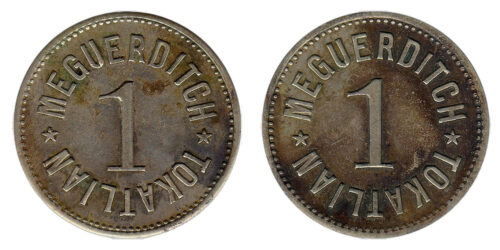
1 (kurush): circular white metal (copper-nickel alloy) 24.6 mm in diameter, die axis 0°, weights of two examples: 4.04 grams, 3.98 grams. Both the obverse and reverse of this token show a large numeral 1 in the center enclosed by a clockwise circular legend naming merchant MEGUERDITCH TOKATLIAN. Border of dots. Words of the name separated by two small stars.[10] ANRO-42
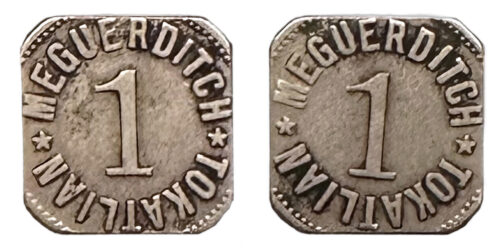
1 (kurush): square white metal (copper-nickel alloy) 20×20 mm in diameter, die axis 0°, weight of the example: 3.1 grams. Both the obverse and reverse of this token show a large numeral 1 in the center enclosed by a clockwise circular legend naming merchant MEGUERDITCH TOKATLIAN. Border of dots. Words of the name separated by two small stars.[11] ANRO-1703
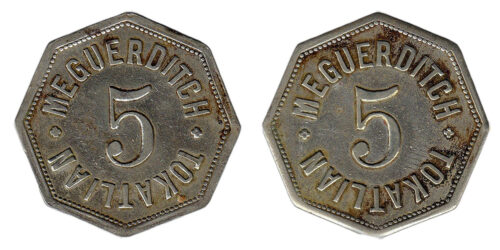
5 (kurush): octagonal white metal (copper-nickel alloy) 27.1 mm diameter point to point, 25.3 mm side to side, die axis 0°, weights of two examples: 5.35 grams, 5.36 grams. Both the obverse and reverse of this token show a large numeral 5 in the center enclosed by a clockwise circular legend MEGUERDITCH TOKATLIAN. Border of dots. Words separated by two small quatrefoils.[12] ANRO-41
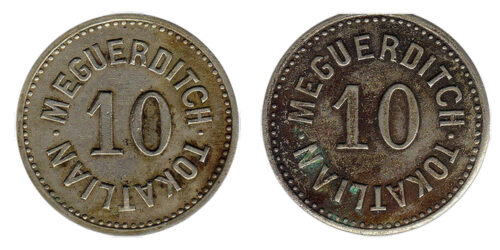
10 (kurush): circular white metal (copper-nickel alloy) 20.4 mm in diameter, die axis 0°, weights of two examples 2.57 grams, 2.46 grams. Both the obverse and reverse of this token show a large numeral 10 in the center enclosed by a clockwise circular legend MEGUERDITCH TOKATLIAN. Border of dots. The words of the name are separated by two small dots.[13] ANRO-40
These tokens were considered mavericks because they did not indicate the location of the issuer. Nevertheless, based on historical data, we can firmly attribute these tokens to Meguerditch Tokatlian, founder and proprietor of the Tokatlian Restaurant and Hotel in Constantinople, whose establishments flourished in the late 1800s and the early 1900s respectively. Constantinople and its environs had a large and prosperous Armenian community (especially prior to the World War I genocide of the Armenians in Turkey) with several dozen churches, national institutions, schools, hospitals, publishing houses, and commercial firms. Many of the leading business establishments in the city were owned and operated by Armenians at this time.
The Tokatlian Hotel, a prominent establishment in Istanbul, has a rich history that reflects the architectural and cultural shifts of its era. Originally built in the 19th century, the hotel was emblematic of the eclectic architectural style that dominated the period. This style, heavily influenced by European trends, was evident in various types of buildings throughout the city, including commercial establishments like the Tokatlian Hotel. In the late 19th century, Istanbul saw an influx of Parisian-style shopping arcades and grand hotels. These structures often combined Neoclassical and Baroque elements, mirroring the architectural developments seen in Western Europe during the same period. The Tokatlian Hotel, with its opulent design and luxurious accommodations, quickly became a favorite among affluent travelers and the elite of the time. It stood alongside other iconic commercial buildings in the Beyoğlu district, known for its vibrant mix of shops, arcades, and cultural venues.
One of the key factors contributing to the Tokatlian Hotel’s significance was its strategic location in Beyoğlu, an area renowned for its commercial and cultural activity. The hotel’s design and amenities reflected the era’s eclecticism, incorporating elements of Art Nouveau—a style that gained popularity towards the end of the 19th century, particularly after the arrival of architects like Raimondo D’Aronco in Istanbul. The Tokatlian Hotel, originally owned by the Armenian entrepreneur Meguerditch Tokatliyan, has a rich and complex history.
Throughout its history, the Tokatlian Hotel has hosted numerous notable events and celebrities, further enhancing its legacy. One of the most famous incidents linked to the hotel is its appearance in Agatha Christie’s novel, “Murder on the Orient Express,” where it served as the setting for the story’s beginning. The hotel has also welcomed various luminaries, including acclaimed director Steven Spielberg, who edited several iconic films during his stay, and other high-profile guests such as Muhammad Ali, George Harrison, and Meryl Streep.
The Tokatlian Hotel is strategically located in the heart of several historically significant and bustling regions. It serves as a major hub for travelers in the Middle East and Europe, standing prominently along vital trade and travel routes. One notable area it connects to is Aleppo, Syria, which is the largest city in the country and has historically been a significant trading post and crossroads since the days of the Silk Road.
The Tokatlian Hotel has made a significant mark on popular culture, particularly through its association with renowned novelist Agatha Christie. Christie is believed to have written parts of her famous work, “Murder on the Orient Express,” while staying at the Tokatlian Hotel. The novel, first published as a six-instalment serialisation in the Saturday Evening Post in 1933, was later released as a novel in 1934. The Pera Palace Hotel in Istanbul, where Christie also stayed, claims that she wrote “Murder on the Orient Express” in its Agatha Christie Room, though the Tokatlian Hotel is also part of her travel narrative related to the book. The story of “Murder on the Orient Express” was inspired by the real-life Lindbergh case, where Charles Lindbergh’s 20-month-old son was kidnapped and held for ransom. This connection to a sensational international event added a layer of authenticity and intrigue to Christie’s novel, further cementing its place in literary history. The impact of Christie’s association with the hotel extends beyond literature. Her work has been adapted into various films, most notably the 1974 adaptation directed by Sidney Lumet and starring Albert Finney as Hercule Poirot. This adaptation brought further recognition to Christie’s connection with the Tokatlian Hotel and its role in her creative process.
A century ago, the Tokatlian Hotel was considered the most prestigious hostelry in Constantinople. According to an undated advertising brochure printed to promote the hotel and touring in the city, the “Hotel M. Tokatlian” was “considered the most luxurious and most comfortable hotel in Constantinople.”[14] It was reported to have many modern conveniences, including electricity services as early as 1914. The Tokatlian Hotel was immortalized in Agatha Christie’s famous mystery novel, “Murder on the Orient Express.”
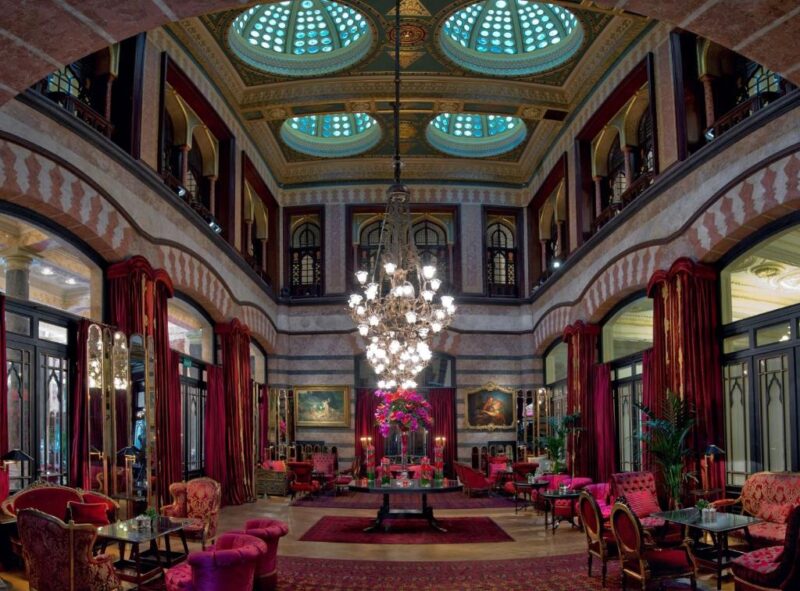
Meguerditch Tokatlian’s initial business venture was a restaurant, which he opened in a very busy section of the Grand Bazaar (the famous covered market) in Constantinople in 1883. After this was proven to be successful, he established a café and pastry shop called the Café Restaurant de Paris. In 1895, he opened a restaurant, coffee shop, and small hotel in a single building, which he expanded in 1909. The Tokatlian Hotel specialized in catering to the needs of foreign diplomats and wealthy tourists. Located on the Grande Rue de Pera near the center of the Pera district, it was within a few blocks of several major foreign embassies, including those of Great Britain, France, Russia, Italy, and the United States. It was also situated in close proximity to numerous parks, gardens, theatres, and foreign hospitals. It boasted 160 rooms for year-round overnight accommodation, including bathrooms and private apartments. The hotel also had large drawing rooms, dining rooms, and an adjoining restaurant equipped with an extensive wine cellar. The restaurant featured French and Eastern cuisine.[15]
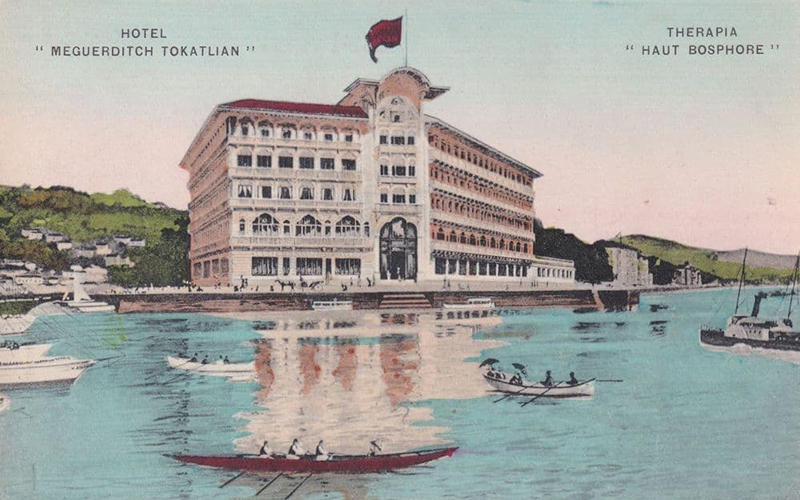
In addition to its establishment in Pera, Tokatlian operated two hotels on the shores of Bosporus which were open during the summer season from May to October. One of these was the Hotel M. Tokatlian at Therapia on the upper Bosporus, and the other was at the Summer Palace. A prosperous restaurant in Grand Bazaar was also maintained.
The use of French (with no Armenian or Turkish script) on the tokens reflects the fact that the hotel clientele was largely European, as well as the fact that French was the preferred European language among the educated classes in Ottoman Turkey. The Tokatlian Hotel was also extensively used by the Armenian community as a gathering place for social functions. Like many other hotels of the grand style, it fell on hard times and eventually succumbed to fire approximately 40 years ago.
Dating these tokens presents a few challenges because with most tokens, no date is indicated directly on the piece. These could have been struck as early as 1883 but were probably not made until the 1890s or the early 1900s. The terminus ad quem was 1928 when the Latin alphabet was adapted for Turkish. Tokens issued after 1928 are expected to spell the family name “Tokatliyan” according to the revised orthography.
The currency unit is also not specified in the token, which requires some explanation. Contemporary US tokens were usually for very small sums (typically five or ten cents); thus, the unit (cents) was not always specified. Businessmen were unlikely to redeem a token labeled five for five dollars unless the word dollars was specified. It is likely that the fact that the currency unit was not specified suggests that (1) these tokens were denominated using the lowest value unit in circulation;[16] (2) all three tokens were of the same currency unit; and (3) the unit was so widely used that it was not necessary to specify it. These tokens were coinage substitutes, and after approximately 1900, the smallest value circulating coins in Turkey were denominated in kurush. If we consider the possibility that these tokens were instead denominated in units of para (40 para to the kurush), we would have to account for the existence of a 1 para token which is substantially less in value than the smallest coin struck in the 1890s. Even in the late 1870s, the smallest value paper church token was the 5 para.[17] The three tokens could easily have been used to pay for food and libation at the Tokatlian restaurants or as gratuities but were probably not used to pay for overnight accommodation.
It may be too much to hope that the discovery of these rare metallic trade tokens will open a completely new field of inquiry in Armenian numismatic research. However, they should alert us to the possibility that other similar tokens may exist. In addition to these tokens, various other types of historical memorabilia have been preserved in Tokatlian establishments. These include postcards, postal stationery, postal seals (so-called “cinderella stamps”), luggage labels, and other forms of ephemeral paper. Hanging from these artifacts is an interesting story that needs to be uncovered and retold.[18]
[1] Y. T. Nercessian, Armenian Numismatic Bibliography and Literature (Los Angeles, 1984), pp. 576- 581.
[2] See, for example, Kenneth M. MacKenzie, “Armenian Church Tokens used in the Ottoman Empire,” International Bank Note Society Journal, Vol. 17, No. 2, pp. 85-94, 1978.
[3] Two published studies mention Armenian metallic tokens. The first is Dr. Paul Bedoukian’s article “Two Armenian Coins” (first published in 1988), which is actually about 19th century Armenian metallic church tokens; see Bedoukian’s Selected Numismatic Studies II (Los Angeles, 2003), pp. 263-266 (in Armenian). Modem brass and plastic transportation tokens from Armenia are described by L. A. Saryan, “Types and Varieties of Yerevan Metro Tokens,” Armenian Numismatic Journal, Vol. 26, No. 3-4, pp. 109-112, 2000.
[4] L. A. Saryan, “Two Centuries of United States Tokens,” N.O.W News, Vol. 43, No. 4, pp. 17-18 (Winter 2005).
[5] G. E. (Gene) Johnson’s Trade Tokens of Wisconsin (Wisconsin Rapids, 1993) is one example.
[6] The Yerevan Metro tokens fall into this category.
[7] Some of the paper tokens issued in the late 1870’s are inscribed in the Armenian language, even though they were issued by non-Armenian institutions.
[8] The spelling “Meguerditch” is transliterated from Armenian using French phonetics.
[9] I obtained two sets of these tokens in 2004 via a dealer in Istanbul, and another collector obtained a
third set. In March 2007, a fourth set of three tokens sold on eBay for over $750.
[10] Detailed examination of this token reveals that the two faces are not exactly identical. One star on one of the faces appears to be doubly punched, while the remainder of the token appears to be free of any sign of doubling. (This can be observed on both examples in my collection.) This observation is a clue that indicates the method of manufacture. To strike this token, at least two identical dies were needed, one each for the obverse and reverse. These dies were prepared individually, probably by punching the lettering into the face of the die. On one of the dies, the star in question was probably punched twice and the punch rotated slightly on the second strike. Also see the next two footnotes.
[11] This example has been added after the original publishing of the article from the following book: Buyurgan, Tunc, and Uslu Kaan. Ottoman Empire & Turkish Republic tokens / Osmanli Imparatorlugu ve Turkiye Cumhuriyeti jeton, marka ve fisleri. Osmanli Nümismatik Yayinlari, 2013.
[12] Miniscule differences in the dot border and in the centering of the large numeral 5 are apparent when the two faces are compared. This is observed on both examples. See footnotes 10 and 12.
[13] Detailed examination shows tiny differences in the dot border above the letter R on the two faces. This is seen on both examples. See footnotes 10 and 11.
[14] Quoted from a pocket-sized multilingual (German, English, French, and Ottoman Turkish) undated folding brochure entitled “Hotel M. Tokatlian Pera Constantinople” (printed prior to 1928). The brochure was printed in Geneva, Switzerland.
[15] This information is taken from the folding brochure.
[16] The logic here is that a more valuable monetary unit (such as the lira, at 100 kurush to the lira) was of enough value that it would have been specified to avoid confusion.
[17] See MacKenzie, op.cit.
[18] The assistance of Manuel Panossian in the research and preparation of this article is gratefully acknowledged.
Saryan, Leon A. “Trade Tokens Issued by Meguerditch Tokatlian of Constantinople.” Armenian Numismatic Journal, vol. 3 (33), no. 4, Dec. 2007, p. pp 81-86.
